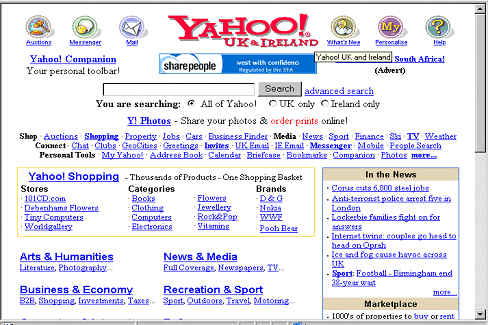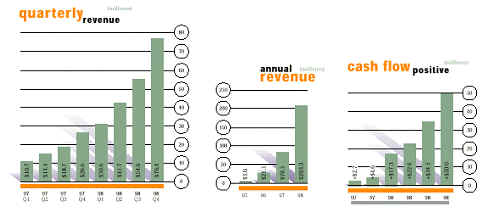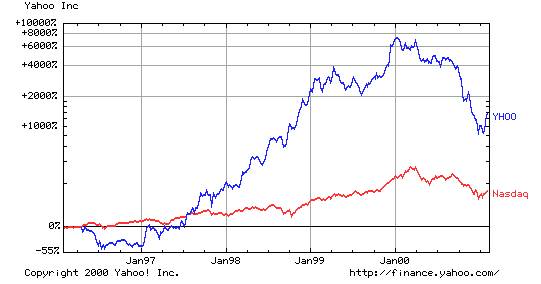Yahoo
Yahoo was created
only several years ago, in 1996 as a personal tracking system by David
Filo and Jerry Yang. Its value upon creation was worthless; it was only
considered a helpful tool to the two creators. Yahoo floated on the
NASDAQ and became a public listed company on April 12, 1996 and the IPO
price was $1.08. Yahoo has even had a maximum share price of $218.0312,
which occurred on the 10th of January 2000.
Yahoo was one of
the first search engines to be launched into cyber space and has become
the world’s most popular website. Its reliability in accurately finding
what the user is searching for has attracted many members. At this
instance of time, it receives 25 million visitors per month and a highly
accessible web site. Also, the immense databases from across the Internet
are gathered and categorised by about 30 professional surfers. Yahoo
is a resounding success and is far removed from the static definition that
applies to a Web search company.

The opening page is a brightly coloured, making it
look user friendly and only a few small icons are displayed so that the
loading time is short. It has facilities to personalise the user's search and it can find
anything the user wishes to find. The page has many different categories
of subjects that users can easily access using to the links. Yahoo has
many servers, which make it possible for the search to be carried out very
quickly, and users do not have to wait long to retrieve the desired
information. Yahoo can be viewed as a commerce-enabled, personal website
with e-mail facilities, reporting and payment processing, apart from
it’s search facilities. Below is a sample of the opening page of the
Yahoo Web site.


Yahoo does not
only exist as YahooUSA, there are also YahooEurope, YahooJapan and
YahooKorea as the company desires to build on a global user based company.
The Company has included online properties in 12 different languages to
accommodate for the ever-growing international consumer population. This
step also makes it more attractive for potential merchants seeking means
of advertising. Yahoo offices have been established in 16 worldwide
locations to ensure the development of their business.

To strive to
become a successful ‘dotcom’ you have to compete in the ever-growing
industry of dotcoms. As it is so easy to link to a competitor’s site,
the service that you provide must be the best. Otherwise, you simply drop
out of the game. As Yahoo was one of the very first search engines to be
launched, it has been capable of capturing the dotcom market. With its
superb services, it has become today’s most popular search engine,
despite the fact that there are many other out there competing fiercely
against it, e.g. AOL and Lycos.
Yahoo obtains
most of its profits by selling advertisements and services to large
companies. Obviously, these large companies are keen on investing in
advertising as Yahoo is so widely used and preferred all round the world.
As a result, investors evaluate Yahoo highly in the dotcom market.
As the hype about Internet companies such as Yahoo
increased, the stock market starts to move in that fashion (towards higher
share prices). It attracted a lot of interest from investors and
advertisers. This attracted even more interest and as more people entered
the stock market, the more enthusiastic they became. The demand for Yahoo
stock was so great but the supply was limited and this caused the share
price to rise.

The following data obtained from the latest published
annual report 1998 was taken to show the progress of Yahoo financially.
The data shows the performance over the lifespan of Yahoo until 1998 and
it is evident that Yahoo has been reaping in profits, from the positive
cash flow, annual and quarterly revenue.

The above data contains statistics that investors and
speculators find attractive. Also shown is the data of income from
advertisers; this is very important because Yahoo obtains majority of its
revenue from advertisers.

A chart of
Yahoo's performance over its life span is shown below, beginning from its
first launch onto the NASDAQ. Considering the fact that Yahoo Is only
about 4 years old, it can be said that its performance is phenomenal as
the share price soared such a large amount in that little time. As
you can see, the general trend of the share price is increasing with time.
Its steep gradient and soaring share price can be regarded as an
indication of the expansion and success of Yahoo.
In comparison to blue chip companies, the gradient of
blue chip companies tends to be very flat, where else for Yahoo it is
obviously steep. This shows that dotcom companies are playing in a
different ball-field and that they are more likely to be in a stock
bubble, with ever increasing share prices, unless of course the bubble
bursts.
Also included below the share price chart and
indicated by the arrowheads are the dates of the stock splits. Yahoo has
split its stocks 4 times. What the stock split does is, for example, a 2:1
split, each shareholder obtains one extra share for each share that they
already own.

Splits:
2-Sep-97 [3:2], 3-Aug-98 [2:1], 8-Feb-99 [2:1], 14-Feb-00 [2:1]

Since the turn of the new Millennium, the share price
of Yahoo has fallen considerably, despite the fact that the share price
peaked in the beginning of January 2000. In just that one year, Yahoo
shares fell 16% following warnings that the economic slowdown would cause
profits to fall short.
More recently, just one day before the company
releases first-quarter earnings, Yahoo's (YHOO)
shares got trounced, along with other Internet stocks, dropping more than
5 points to $93.25. This fall occurred the day after a French judge forbid
the sale of Nazi memorabilia on Yahoo. The drop in Yahoo's stock price can
be partly attributed to two negative analyst reports from Merrill Lynch
and Morgan Stanley Dean Witter.
"These
stocks were almost going vertical. There wasn't much in the way of
analytics going on, it was almost pure emotion,” Piper Jaffray
technical analyst Ed Nicoski said.
The occurrence of this was exactly opposite to what
was predicted for Yahoo a year ago. Yahoo only began reaping in profits in
the last eight months and already, there are speculations that Yahoo is
overpriced and is heading for a great fall. Despite this, Yahoo has been
held up as one of the few Internet businesses actually turning a profit.

Yahoo plans to
keep up its performance by starting up new partnerships with companies
such as Hot Jobs Inc., which is also an advertiser for Yahoo and add new
content to the existing service. For the full year 2001, Yahoo
expects revenues to be $1.2 billion to $1.3 billion, business segments for
advertising/commerce and business services representing 80%-85% and
15%-20% respectively. As one can see, Yahoo depends a lot on advertising
for its revenues
As quoted from
the Yahoo COO Jeff Mallet, “We
want people to say ‘I may not know exactly where I’m going, but I know
that can get me there’”. This statement sounds very promising from
the point of view of facilities offered by Yahoo but this does not have
any correlation with the financial state that Yahoo is in.
“As an
Internet leader, Yahoo constantly reviews and enhances its products based
on consumer response and need,”
said Tim Brady, senior vice president, Network Services, Yahoo. "The improvements we are making in our commerce properties will
help ensure that we maintain the highest quality online experience
available to buyers and sellers."

Yahoo is a very
reputable dotcom company that has performed extremely well in the dotcom
market, even through times when other dotcoms have failed. It is often
used as an example of a dotcom company in an Index. Its performance
appears to fluctuate due to comments made by analysts in investment
banking and other external factors.
From the chart of
share performance, Yahoo’s performance is compared to the NASDAQ Index.
There is an obvious observation that both the graphs follow a similar
shape and they reach a peak at the same time. This shows that Yahoo’s
performance on the NASDAQ is closely correlated.
|